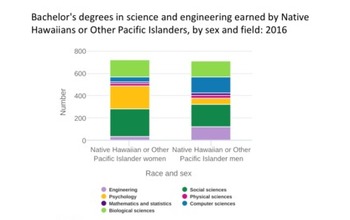Stat Insights: Asian/Pacific Americans in Science and Engineering

Bachelor's degrees in S&E earned by Native Hawaiians or Other Pacific Islanders, by sex and field
May 29, 2019
The National Science Foundation's National Center for Science and Engineering Statistics (NCSES) celebrates Asian/Pacific American Heritage month with some insightful statistics about the contributions of Asian, Native Hawaiian, and Pacific Islanders in science and engineering (S&E).
While Asian citizens and permanent residents, ages 18 to 64, comprise only 4.9% of the U.S. population and 6.1% of the labor force, they are well-represented in higher education, particularly in S&E. For instance, in 2016, Asians earned 6.9% of all bachelor’s degrees, and 9.9% of all S&E bachelor’s degrees. They received 7% of all doctoral degrees and 9.1% of doctoral degrees in S&E. This strong academic showing is reflected in the workforce. In 2017, Asian citizens and permanent residents constituted 13% of the S&E workforce. Moreover, Asian scientists and engineers tended to earn about $10,000 more than the median salary for all scientists and engineers.
Although the population of Native Hawaiians and Pacific Islanders is far below that of Asians — 0.2% compared to 4.9% — Native Hawaiians and Pacific Islanders are proportionally represented in higher education, in general, and in S&E, in particular. In 2016, Native Hawaiians and Pacific Islanders earned 0.3% of all bachelor’s degrees, with 0.2% of those in science and engineering. In the workforce, Native Hawaiians and Pacific Islanders comprised 0.2% of scientists and engineers. Like their Asian counterparts, Native Hawaiians and Pacific Islanders typically earn a higher salary of about $5,000 above the median for all scientists and engineers.
See a broad range of statistics about Asian, Native Hawaiian, and Pacific Islanders in science and engineering in NCSES’s special report, Women, Minorities, and Persons with Disabilities in Science and Engineering.
The U.S. National Science Foundation propels the nation forward by advancing fundamental research in all fields of science and engineering. NSF supports research and people by providing facilities, instruments and funding to support their ingenuity and sustain the U.S. as a global leader in research and innovation. With a fiscal year 2023 budget of $9.5 billion, NSF funds reach all 50 states through grants to nearly 2,000 colleges, universities and institutions. Each year, NSF receives more than 40,000 competitive proposals and makes about 11,000 new awards. Those awards include support for cooperative research with industry, Arctic and Antarctic research and operations, and U.S. participation in international scientific efforts.
Connect with us online
NSF website: nsf.gov
NSF News: nsf.gov/news
For News Media: nsf.gov/news/newsroom
Statistics: nsf.gov/statistics/
Awards database: nsf.gov/awardsearch/
Follow us on social
Twitter: twitter.com/NSF
Facebook: facebook.com/US.NSF
Instagram: instagram.com/nsfgov


